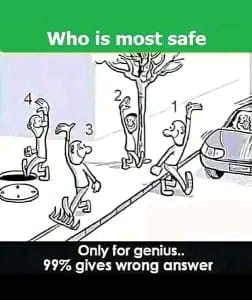Title: Evaluating Safety in Everyday Scenarios: A Critical Analysis

ADVERTISEMENT
Title: Evaluating Safety in Everyday Scenarios: A Critical Analysis
Introduction:
Safety in daily life is often taken for granted, yet the potential for accidents is ever-present. An interesting and engaging method to illustrate this is through visual puzzles that challenge viewers to identify who in a given scenario is safest. These puzzles not only serve as brain teasers but also provide valuable lessons on the dynamics of safety in different environments.
Discussion: Consider a typical scenario depicted in a visual puzzle where multiple characters are engaged in activities near potential hazards. For example, imagine four individuals:
- A person standing under a tree.
- Another climbing a tree.
- A third walking on a seesaw.
- And a fourth observing an open manhole.
Each individual in this scenario faces unique risks:
ADVERTISEMENT
- The person under the tree might be safe at a glance, but there’s an inherent risk of falling objects, or even lightning strikes if weather conditions change.
- The individual climbing the tree is at risk of falling due to unstable footing or breaking branches.
- The person on the seesaw is likely to lose balance, especially if there’s any sudden movement from the other end.
- The observer near the open manhole, while seemingly aware of the danger, might still be at risk if distracted or if there’s insufficient lighting, leading to a potential fall.
Analyzing Safety: To determine who is the safest, one must consider both the immediate risks and the potential for accidents:
- The individual under the tree, depending on the tree’s health and weather conditions, could be considered relatively safe compared to others.
- The climber faces immediate danger and requires constant alertness and physical stability to ensure safety.
- The seesaw walker deals with an unstable platform, which is inherently risky without careful balance.
- The observer near the manhole, while aware of the nearby hazard, remains at risk of distraction or misstep.
Conclusion: In such puzzles, and by extension in real life, assessing safety often requires a comprehensive understanding of environment, personal awareness, and the unpredictable nature of accidents. The safest individual is typically the one who is not only aware of their surroundings but also positioned away from immediate hazards. These visual puzzles are excellent tools for teaching critical thinking and safety awareness, underscoring the need for vigilance in everyday life scenarios. They encourage viewers to think beyond the obvious and consider multiple factors that could affect safety, making them a valuable educational resource in risk assessment and accident prevention.




